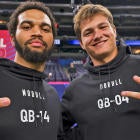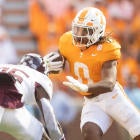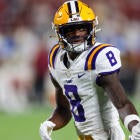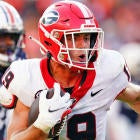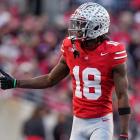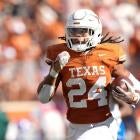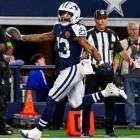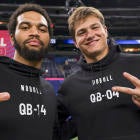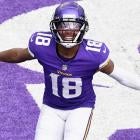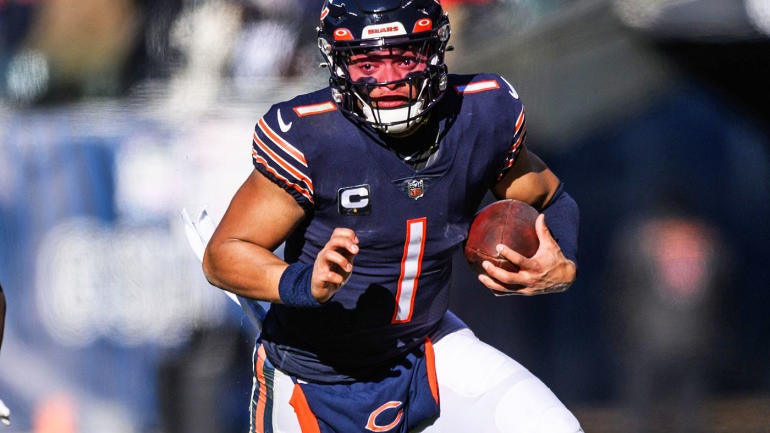
Every year there are a few breakout candidates so obvious that pretty much everyone in the Fantasy Football industry agrees on them -- no small feat, given how much Fantasy analysts love arguing about, well, everything. In 2022, it worked out really, really well in the case of Jalen Hurts, who was pretty much the free square on the board when it came to QB breakouts and who turned in an elite season.
Other consensus breakout picks didn't work quite as well. A.J. Dillon and Courtland Sutton mostly treaded water (at best!) while Gabe Davis certainly flashed, but overall was a pretty big disappointment. And it's better for all of us if we don't talk about what happened with Kyle Pitts last season – it's certainly better for my rep as an analyst, at least.
Which is all to say, there's value in following the wisdom of the crowd, but predicting which players will take a step forward in any given year is a tough thing to do. There's going to be a lot of overlap in breakout picks for 2023 – guys like Justin Fields and Garrett Wilson are likely going to be the "free space" this year, and Wilson is a breakout pick for Jamey Eisenberg, Dave Richard, Heath Cummings, and myself this year – but history suggests there are going to be some bumps in the road for even the most obvious breakout candidates.
In yesterday's newsletter, I gave you sleeper picks from the entire FFT team – you can check those out here – and today we're moving on to breakout candidates. Breakouts and sleepers tend to have some overlap, but there are, in my eyes, two key distinctions: Sleepers tend to be, on the whole, cheaper; and breakouts tend to carry even more certainty with them. Sleepers are guys you're interested in and want on your team; Breakouts are the guys you have to have.
Here are our breakout picks for 2023:
My Breakouts
Justin Fields, QB, Bears
A breakout already happened for Fields when he was fully unleashed as a runner in 2022, racking up 1,143 yards and eight touchdowns on the ground – including a comical 95 yards per game over his final 10 games. However, as a passer, Fields was very much still a work in progress, with just one game of more than 250 passing yards last season, and only one in two seasons with 200-plus yards and multiple passing touchdowns. The Bears are investing in Fields as their QB of the future, trading down from the No. 1 pick to acquire D.J. Moore, who immediately becomes the best wide receiver Fields has played with. It's unfair to make the Josh Allen or Jalen Hurts comps, but Moore could have a similar impact that Stefon Diggs and A.J. Brown had for their quarterbacks, at least directionally, if not to quite the same extent. The thing with Fields is, he's such a dominant rusher, that if he just gets to, say 200 passing yards and 1.5 passing touchdowns per game, you're probably looking at a top-five QB.
J.K. Dobbins, RB, Ravens
I've never been in on Dobbins, and I haven't really had much reason to regret that yet. It's never been a talent issue – he's a very, very good runner, and playing alongside Lamar Jackson has made him hyper-efficient in his time in the NFL in a way that seems sustainable. Part of the problem is because Jackson is such a dynamic rusher, he never really throws to his running backs – just 8% of Jackson's career targets have gone to running backs. That limits Dobbins' upside in PPR leagues, but I still think there's room for a breakout season here if the switch from Greg Roman to Todd Monken as the Ravens offensive coordinator leads to a change in how the team handles its running backs. Roman constantly cycled between backs, to the point where a running back only had 15 or more carries 22 times in four seasons with Roman as offensive coordinator. In new OC Todd Monken's three years as the Buccaneers coordinator between 2016 and 2018, it happened 30 times; it happened an additional 15 times in Monken's lone season with Cleveland. If Dobbins stays healthy (and Jackson re-signs, of course), he should be in line for by far the best numbers of his career, and should be a solid RB2 if healthy.
David Montgomery, RB, Lions
Montgomery has a top-five finish under his belt, so how can he be a breakout candidate, you might ask? Well, he's never been in a better situation than the one he's going to be in Detroit. Sure, D'Andre Swift is a looming threat to touches, but the fact that the Lions went out and signed Montgomery is, in and of itself, a sign that Swift probably doesn't have the coaching staff's trust. Montgomery is a better player than Jamaal Williams, and while I think it's unlikely he replicates Williams' 17 touchdowns from a year ago, replacing his 274 touches seems like a pretty safe bet. Montgomery should get the majority of the carries here, and if he even gets to 50 targets (Williams had 16), he could be a top-12 RB this season.
Garrett Wilson, WR, Jets
In nine games with Zach Wilson last season, Garrett Wilson averaged 8.82 PPR points per game; in eight games with literally any other quarterback, he averaged 17.3 points. Wilson, you may be aware, isn't just going to have any QB throwing to him this season, but a four-time MVP. It's fair to be skeptical about whether Aaron Rodgers can be an MVP-level quarterback again, but seeing as Wilson looked like an elite receiver working with Mike White, Joe Flacco, and Chris Streveler, Rodgers just has to be decent to feel pretty confident in Wilson's chances of breaking out.
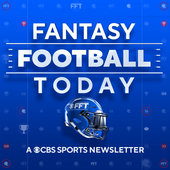
Fantasy Football Today Newsletter
Know What Your Friends Don't
Get tips, advice and news to win your league - all from the FFT podcast team.
Thanks for signing up!
Keep an eye on your inbox.
Sorry!
There was an error processing your subscription.
Chris Olave, WR, Saints
I wish I had the courage to rank Olave ahead of Wilson, but I can't bring myself to do it. Not yet, anyway. But my expectations for Olave are sky high after a rookie season where he had 1,052 yards in just 15 games – and he played fewer than half the snaps in two of those 15, to boot. Olave stepped on the field as a rookie and earned a 24.8% target share, the 22nd-highest mark in the league, just ahead of, among others, Travis Kelce and Deebo Samuel. That's impressive in its own right – Wilson was at 22.7%, for example – but it becomes even more impressive when you realize how often Olave was being targeted down the field. His average depth of target was 14.2 yards down the field, the highest of any player with a target share over 20%. That's a super intriguing combination, especially with a QB upgrade coming in the form of Derek Carr. If the Saints are more pass heavy and Olave maintains anything like a 25% target share, he's going to be a superstar.
Michael Pittman, WR, Colts
I've long been skeptical of Pittman, but his struggles last season had nothing to do with him and absolutely everything to do with the Colts offense being completely dysfunctional. We don't know who will be taking over at QB for the Colts in 2023, but it's almost certainly going to be a very talented rookie who should give them more than the desiccated husk of the quarterback who once was Matt Ryan. Pittman is a proven target earner (26.4% last season) who has very little competition for targets. There will be ups and downs with whoever the rookie QB is here, but I think it'll be an upgrade, and Pittman could be in line for career-best numbers.
Kyle Pitts, TE, Falcons
The only player with a higher target share and higher average depth of target than Olave? Pitts. Now, partially, that was a function of the Falcons being an absurdly low-volume passing offense, but I don't think it's a stretch to expect Pitts to continue to earn 25% or more of his team's targets moving forward. The question is whether he can get back to the neighborhood of his rookie season catch rate of 61.8% as the Falcons (hopefully) revert to the league average in pass rate. I'm going to keep betting on the elite prospect who won't even be 23 until the second month of the season.
Jamey Eisenberg's Breakouts
Kenneth Walker, RB, Seahawks
It's no surprise that Pete Carroll was excited about what Walker did as a rookie and optimistic he'll improve in his second year when I talked to the Seahawks coach at the NFL league meetings in late March. I liked that Carroll, unprompted, said Walker will get more work in the passing game in 2023. "He'll get a lot better," Carroll said. "He'll be more accurate with the opportunities and knowing the situations, maximizing his shots when he gets them. We'll get the ball more throwing it to him. I think he's going to make a really big next step from his rookie year." As a rookie, Walker took over as the lead running back in Seattle in Week 6 against Arizona, and he scored at least 12 PPR points in nine of his 10 remaining healthy games. Over those 10 games, Walker averaged 16.3 PPR points per game, which would have been good for the No. 6 running back in 2022. I expect Walker to be a top-five running back this season, and he's worth drafting in the top 15 overall picks in all leagues.
Chris Olave, WR, Saints
Olave should improve with Derek Carr as the starting quarterback for the Saints after Olave suffered playing with Andy Dalton for the majority of his rookie campaign. While the stats were encouraging -- 72 catches for 1,042 yards and four touchdowns on 119 targets for 12.9 PPR points per game -- Olave left a lot of production on the field. He was sixth in the NFL in air yards among wide receivers (1,686), seventh in targets per route run (targeted on 31.2 percent of his routes) and sixth in yards per route run (2.73). Prior to Week 13, Olave was actually No. 10 among all wide receivers in targets (92) and receiving yards (822) and 15th in receptions (56). At that time, he was on pace for 143 targets, 87 catches and 1,270 yards. He suffered a hamstring injury in Week 15 and was out for Week 16, and he struggled down the stretch. But he should rebound in a big way this season with Carr. Even though Michael Thomas remains in New Orleans, Olave is the top receiver to target for the Saints, and Fantasy managers should plan to draft him as early as Round 3.
Chigoziem Okonkwo, TE, Titans
I recently caught up with Okonkwo while he was training at XPE Sports in South Florida, and he's been working on improving his game since February. I expect Okonkwo to have a second-year breakout campaign, and he's worth drafting as a No. 1 Fantasy tight end with a late-round pick in all leagues. He fits the bill of what we look for as a starting option with upside because he could be first or second on the Titans in targets. This is an inexperienced receiving corps led by second-year guys in Treylon Burks, Kyle Philips and Okonkwo, and Ryan Tannehill should lean on Okonkwo a lot. As a rookie, he had plenty of positive moments down the stretch with at least 10 PPR points in three of his final six games, including two touchdowns over that span. He averaged 9.5 PPR points during that time, and that actually would have made him the No. 9 tight end in PPR if he did that for a full season. Tannehill also played in just three of those games, and Okonkwo is excited to have his starting quarterback return for 2023. He told me his goal is 100 catches this season, which doesn't seem realistic, but I wouldn't be shocked if he doubled his production from 2022 (32 catches, 450 yards and three touchdowns on 46 targets). He's an elite athlete and primed for a lot of opportunities this season, and he could finish the year as a top 10 Fantasy tight end in all leagues.
Dave Richard's Breakouts
Tony Pollard, RB, Cowboys
Yep, Pollard has a shot to beat his numbers from 2022. He's proven to be among the league's most elusive running backs, ranking among the top-15 last year in yards after contact per rush (3.82 yard average), explosive play rate (11.9% of his runs went for 12-plus yards) and Pro Football Focus' elusive rating (14th among qualifiers). Fantasy managers are ready to buy into Pollard based on those traits, but are the Cowboys? Team owner Jerry Jones said in March he believes he's "an integral part of looking forward," but there are plenty of people who think the team will draft a physical running back to complement Pollard. That would not only hurt his overall touch numbers but also his short-yardage touchdown potential. Still, Pollard should have a crack at exceeding the 232 touches he had in 2022 and potentially march over 1,400 total yards, even with a teammate helping him in the backfield. And if there isn't substantial help and Pollard has a path to handle most of the work, then he has top five overall upside.
Jerry Jeudy, WR, Broncos
Maybe it'll just take Jeudy not getting hurt for a career year. Or perhaps he can just play like he did in his final five games of 2022 (14.6 PPR points in four of those five). Or, and this isn't that much of a stretch, we can count on Sean Payton utilizing Jeudy to his absolute strengths much like he did for years with Michael Thomas. No matter the hope, optimism remains for Jeudy since he finished last season as Denver's top receiver. A change in offensive systems should create some better chances for him to make big plays and easily beat the 1,012 total yards and six scores he had in 2022.
Drake London, WR, Falcons
Even when London was on the field with Kyle Pitts and had to deal with Marcus Mariota's throws, the then-rookie earned a 26.9% target share and scored four times (all in the red zone). His volume popped when Desmond Ridder was under center and Pitts was sidelined, naturally earning a much higher target share (32.7%) and connecting with Ridder (69.4% catch rate) unlike other Falcons players in those final four games. The hunch is that Ridder will continue leaning on London not only as a short-area target and as a red-zone weapon, but also as a contested-catch beast who can use his physical style to add numbers after the catch. And as last year proved, London should still wrangle a healthy target share even with Pitts playing. He has No. 2 wideout upside in full PPR, but that upside shrinks in leagues where catches do not count as much.
Heath Cummings' Breakouts
Christian Watson, WR, Packers
If you get really creative with Watson's splits, you could make the case for him as the best rookie receiver. He averaged 11.7 PPR FPPG despite playing less than half of the offensive snaps in five of six games. From Week 10 on, he was the No. 10 WR in Fantasy, thanks largely to the eight touchdowns he scored on 35 touches. Watson's upside case starts with Jordan Love being nearly as good as Rodgers was last year. While Watson will not likely match last year's touchdown rate, if he can remain a high-touchdown rate guy and stay healthy, he could be looking at double-digit scores and a top-15 season at wide receiver. Start looking for Watson at the end of Round 3.
Trevor Lawrence, QB, Jaguars
Lawrence doesn't have the same upside as Fields, because he doesn't run as much. But there are some similarities. Lawrence also had an elite four-game stretch (Week 12-15) where he averaged 29.9 FPPG. He also added a potential new No. 1 wide receiver, in Calvin Ridley. If Lawrence continues his progression in Doug Pederson's offense and Ridley is the same guy he was two years ago, a top-five season is well within reach for Lawrence.
Rachaad White, RB, Buccaneers
With Tom Brady and Leonard Fournette gone, the Buccaneers appear ready to hand the feature role off to Rachaad White. The Bucs have talked about White being a three-down back, and so far the only back they've added is Chase Edmonds. If Baker Mayfield or Kyle Trask dump the ball off to their running backs as often as Tom Brady did, then White has some serious PPR upside. Like Pollard, he needs to dodge landmines during the 2023 NFL Draft, and if he does he's worth a look as early as Round 4 in Fantasy drafts.














